A MiG-15 Caused My Best Greased Landing in an F-86 Sabre
This article marks the second story from Bill’s Korea Files. Click here to read part 1.
August 18, 1951
It began as another hot, sultry day, typical of South Korea in mid-August. Today, however, would be one to remember, as I was scheduled for my 6th combat mission over North Korea. We were flying F-86As out of K-13 (Suwon Air Base), which was a few miles west of the ancient walled city of Suwon, South Korea. Our mission was to fly north to the Yalu River and provide top air cover for the F-84s and F-80s against the MiG-15 fighters. The F-84s and F-80s were doing interdiction raids over North Korea on bridges, roads, and railheads.
The mission briefing in Combat Operations proceeded as it normally did. The area we were to cover extended along the south side of the Yalu from a reservoir at Changsang-ni to Sinuiju (Sinŭiju), which was where the Yalu River met the Yellow Sea. Our patrol altitude would be 35,000 feet, the weather was to be a high overcast, with a broken cloud ceiling around 7,000 feet that would have clear windows for takeoff and hopefully our return. Luckily, the weather over North Korea was clear.
“Bingo Fuel” was set at 250 gallons, which meant when the first plane got down to 250 gallons of fuel, the squadrons would begin their flight home. Of course, the MiG’s were quick to figure out that “Bingo” meant low fuel, and so when they’d hear that in a transmission, they would initiate an attack. What they learned the hard way was that 250 gallons gave us more than enough fuel to respond to their attacks. The dogfight that would follow usually resulted in their losing and running away. By that time our fuel would truly be at a minimum or below, so there were a lot of reduced power glides back to base after fights like that.
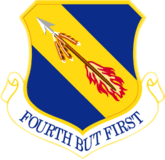 It should be noted that at this time we were forbidden to cross the Yalu River into Manchuria under any circumstances. To do so would result in an immediate transfer out of the 4th Fighter Group, and no one wanted that to happen.
It should be noted that at this time we were forbidden to cross the Yalu River into Manchuria under any circumstances. To do so would result in an immediate transfer out of the 4th Fighter Group, and no one wanted that to happen.
Our Group consisted of 16 aircraft, divided into 4 flights named Red, White, Blue and Green. Our tactics employed the four-ship flight formation which looked like the fingers on your hand (excluding your thumb, of course). The middle finger was call sign “Color 1” (e.g. Red One, Blue One), who would be the leader. The index finger was #2, the leader’s wingman. The ring finger was #3, the leader of that element, and the little finger (#4) was his wingman. In a dogfight you never broke down below a 2-ship element, e.g. Blue One and Two would be an element, or Green Three and Four. In the event that you did become separated and all alone, head home quickly!
The responsibility of the wingman was to provide cover for the leader. This meant that if you were on the right side of the leader, he scanned the sky clockwise from the 11 to 06 o’clock position. If on the left side, counter clockwise from the 01 to the 06 o’clock position. The leader’s responsibility was to be the hunter and cover the open positions.
After strapping in we fired off our engines, and upon Red One’s command, proceeded with our very brief radio check-in: “Red 1-2-3-4, White 1-2-3-4,” etc. This was done to keep the enemy, who monitored all our radio transmissions and had spies on the ground, from determining exactly who was flying that day. Over time they became familiar with all of us.
Prior to Take-off, you taxied to the armament area where the “Armers” charged your guns. Depending upon your position in the group, your element took the runway and took off. The leaders of each Flight would throttle back after take-off to allow his element to join up. In turn, the Flights joined together and the 16 aircraft proceeded north together.
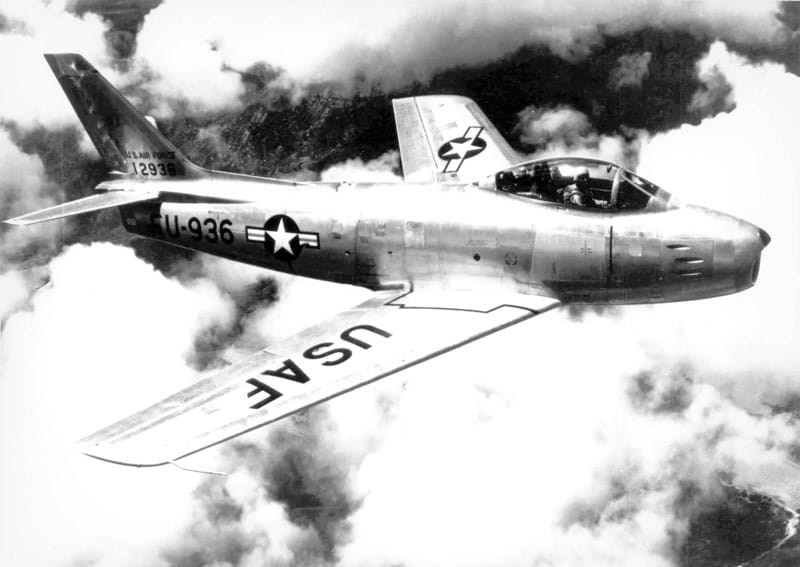
After crossing into North Korea and upon command from Red Leader, you would spread out the formation and test your guns to assure that they had been correctly armed and were functioning. You learned to squeeze off a very short burst of 5 to 6 rounds to save ammunition. Each F-86 Sabre had six .50 caliber machine guns mounted in the nose. The rate of fire from each gun was about 1100-1200 rounds per minute, but the maximum ammo per gun was only 200 rounds. Consequently, when in combat you fired in short bursts to not only conserve ammunition but to avoid overheating the guns.
The MiG-15 armament consisted of two 23mm cannons and one 37mm cannon. The rate of fire of the 23’s was 200-300 rounds per minute, and the 37mm was about 150 rounds per minute.
After re-joining, the Group proceeded north to 35,000 feet and set up our patrol along the Yalu. The MiG-15s were based at Antung, which was on the north side of the mouth of the Yalu. Their airfield was quite visible to us and we could watch them take off, climb to altitude and fly adjacent to us on the north side of the river. They knew we were not allowed to cross over the river and used it to their advantage.
Some days the MiGs stayed north, and on other days they ventured south and engaged us. There was no way to know their plans because they weren’t consistent. The MiG pilots were a varied lot. Initially, there was a small group of International pilots made up of East Germans and Poles left over from World War II, as well as a large number of Chinese and some North Koreans. Then, about this time the Russians began arriving.
Enemy Capabilities and Performance
The Chinese pilots were so-so, the North Koreans were terrible, and the Russians were unfortunately pretty good. On this day, after the F-84s and F-80s had departed after the first Bingo call, we began our withdrawal back to base until the MiG’s came over on attack. They came over in several waves of approximately 70-80 aircraft. We were always outnumbered at least four or five to one, so this looked pretty normal.
When a fight erupts you are immediately broken down into your 2-ship element, and radio communications are kept to a minimum. They are used to identify targets of opportunity, and the location of possible threats. The one call that is absolute and unquestioned is the wingman’s transmission to his leader of “Break Left” or “Break Right.”
As a wingman, you learn to know the critical firing distance of an attacking MiG and not break too soon, which gives a definite advantage, or break too late, putting him now in lethal range. As a leader when you hear “Break,” you break hard and right now – no hesitation.
Aerial combat is a very strange experience. When you are in the middle of the fight, the sky is filled with planes going through every possible maneuver. One moment you’re the aggressor, the next you’re under attack. All of this while diving and climbing at 400 to 500 knots and pulling 4 to 6G turns. It’s no wonder that pilots all develop hemorrhoids!
During this fight, my leader and I suddenly found ourselves outside of the main fight at about 30,000 feet. He proceeded in a gradual right-hand bank with me inside on the right. Gradual turns like this are never a smart move when the enemy’s near because you minimize your ability to visually sweep the skies. Suddenly I saw a “basketball” coming in from my blind side around 4 o’clock; my leaders’ cover spot.
When the MiG fired his 37mm cannon, the projectile literally looked like a flaming basketball as it went by. I called to my leader to “Break Right!” but he continued his gradual right-hand turn. I called again, “Blue Three, Basketballs at 3 o’clock, Break Hard Right!”
Suddenly, there was an explosion, a deafening thud, rapid decompression, and shuddering of my aircraft.
Instinctively, I dove back into the line of fire, which was usually the best evasive maneuver. As I dove through 0.9 on my Mach Meter, I could see out of range a MiG break off a climb for altitude and head north. I righted my aircraft, turned south and headed along the coast. Finally, I was able to take stock of the situation. Apparently, I had taken a pretty good hit along with the airplane.
It’s funny, the things you think about first at a time like that. I remember asking myself the question: Are you alive or dead? When you stop and think about it, how do you really know?
271 Days of Combat
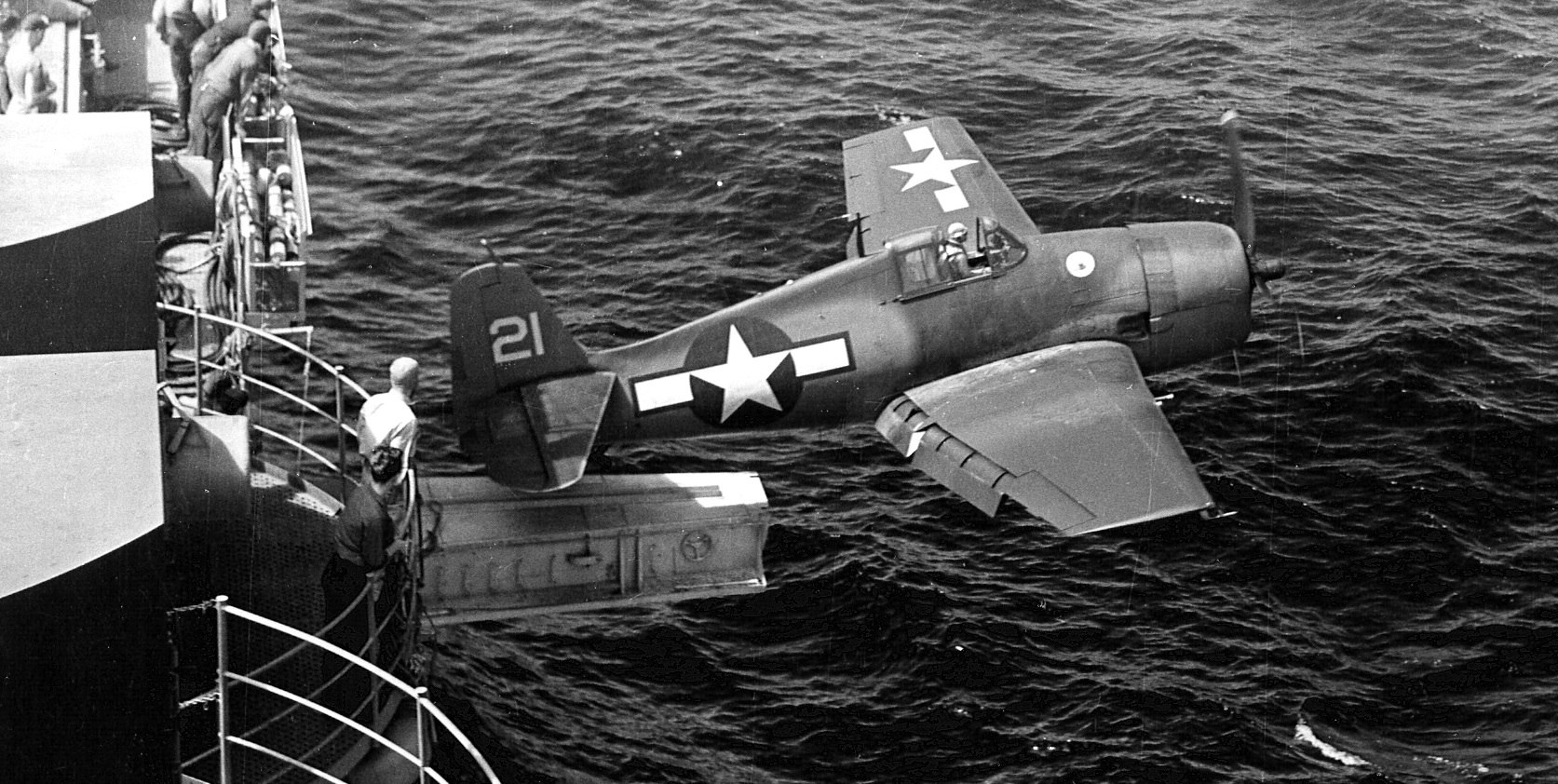 Nat’s first combat came on April 30, 1944. Truk, a valuable Japanese base for air and sea operations, had been hit before, and it was time to finish the job. Hit at daylight by other carrier aircraft, Truk’s oil storage tanks were already on fire and spewing black smoke. In a flight of four, Nat dove his Hellcat through a hole in the smoke, his six 50-caliber guns blazing. Braving a continuous rain of ack-ack, the fighters destroyed [Click here to read more…]
Nat’s first combat came on April 30, 1944. Truk, a valuable Japanese base for air and sea operations, had been hit before, and it was time to finish the job. Hit at daylight by other carrier aircraft, Truk’s oil storage tanks were already on fire and spewing black smoke. In a flight of four, Nat dove his Hellcat through a hole in the smoke, his six 50-caliber guns blazing. Braving a continuous rain of ack-ack, the fighters destroyed [Click here to read more…]
First, I could see blood coming from my right hand and arm. Is that a good sign? Dead bodies bleed for a while, right? Then the adrenaline wore off slightly and the pain began (that’s a good sign), so I must be alive. Something had struck me on the right thigh, and it hurt so badly, I couldn’t look at it for fear of what I might see. Okay, I thought, enough about me, what about my airplane?
Although the Plexiglas canopy had been shot away, the mirrors looking aft on the frame were intact. Through the right-hand mirror, I could view my right horizontal stabilizer and it was not in good shape. It had taken a direct hit from the 37mm and was almost torn in half, and bent at a 45-degree angle. The engine instruments all appeared normal, with no overheat or over-temp lights on. This told me the powerplant did not take a hit.
Now, I forced myself to at my leg. There was no blood, and my foot and toes wiggled fine, so something just must have hit me a glancing blow. I tried to call to my leader to tell him the situation, but I had no radio. That’s when I remembered our VHF radio antenna was embedded in the vertical stabilizer, which was no doubt shot out. All aircraft carried what we called a Parrot, which sent out a radar signal that ground control could track. Our normal setting was Mode 3, and Mode 4 was for emergency situations. I switched to Mode 4 hoping that if everything didn’t work out, they would know where to look for me.
Now all I had to do was keep it together for approximately 200m to home base. The F-86 Sabre radio compass antenna was located in the aft portion of the cockpit behind the pilot’s seat, so I tried turning it on, and luckily it worked. I dialed in K-13, and the needle homed in on the station. I put the needle on the 12 o’clock position and pressed on. I glanced off to my right and saw my leader, who was waggling his wings for me to join up. I waggled mine asking him to join me instead.
Without radio, we waggled back and forth a few more times before he came over to see why I was being such a blockhead. Although his oxygen mask covered his face, I’m sure he had a look of astonishment when he saw my aircraft. As I learned later, he wasn’t aware of what had happened. Now I became worried about going into shock. We had always been taught that shock could take over without any warning, so I tried to think about everything except my right hand, arm and leg. My concern now centered on the weather at K-13.
Although my flight instruments looked normal, could I trust them? Through signal, I tried to have my leader resume the lead. He didn’t understand and I thought better than to fly my damaged wing. The question came to mind, do I bail out or stay with it? As we approached the area of the field, the clouds below us looked overcast. About then I got a 180 needle swing on my non-directional beacon and knew we had crossed the station. I looked below my left wing at a hole in the clouds, below which lay the runways of K-13. I made a sharp left-hand turn and down we went. The overcast was about 7,000 feet, and I leveled off at 5,000.
Now I asked myself, what’s she going to feel like on landing? The canopy’s gone and the tail is chewed up. During our journey home, there had been other enemy activity I was unaware of. Dennis Charlie, our radar control ground site, had picked up my emergency radio transmission. They communicated with the various groups to see if they had an aircraft in trouble. My leader had contacted our Combat Operations (CO), told them of the situation, and that the aircraft looked shot up. Our group told Dennis Charlie it was their aircraft, and that I was headed home, but continue to monitoring my progress.
I would learn later that after I leveled off at 5,000 feet, my leader and CO had this kind of conversation:
Combat Ops: “Blue Three, how is Blue Four doing?”
Blue Three: “He has leveled off at 5000 and slowing down. Speed brakes just came out.”
Combat Ops: “It he preparing to bail out?”
(There had been a similar event about three weeks earlier when the pilot did successfully eject from the aircraft just west of the field.)
Blue Three: “I can’t tell. He is giving no sign and slowing way down.”
Combat Ops: “Give him room; stay with him and keep us posted.”
Blue Three: “Roger.”
In the meantime, I was slowing the aircraft down and setting up a simulated landing with gear and flaps to get a feel of handling characteristics and stall speed due to the increased drag caused by enemy fire.
Blue Three: “Blue Four has lowered his gear and flaps and slowing down to landing speed.”
Combat Ops: “Sounds like a rational thing to do.”
Blue Three: “Gear and flaps are up- he’s motioning to go in for landing.”
With the aircraft set up in landing configuration (gear and flaps down), I slow to within 10 knots of normal touchdown speed and felt some mild buffeting. I figured coming in 15 knots over normal touchdown would be safe, and leave plenty of room on the runway to stop. One more check of my engine instruments, electrical, and hydraulic systems assured me that everything was fine. As I began my descent into the traffic pattern, Blue Three called the tower: “K-13 Tower, this is Blue Three, coming in with a wounded Dumbo.” (“Dumbo” after Walt Disney’s mute elephant became the aviator’s universal term for an aircraft without a radio.)
K-13 Tower: “This is K-13 tower. K-13 is now closed to all traffic. Those on base leg, continue your landing. All other aircraft clear the airspace; the field is closed until further notice.”
Blue Three: “K-13, we are on Initial.”
K-13 Tower: “Blue cleared to land.”
I came in on Initial, which is 1000 feet above the runway at traffic pattern speed. Before I came to the tower, I waggled my wings signifying to the tower that I had no radio, not sure whether Blue Three informed them or not.
As I passed the tower they gave me a green light. For some reason, after all that had taken place in the last 40 minutes or so, that green light seemed to say that everything was okay. That little bit of euphoria was rather short lived.
As I turned from Base to Final with flaps down and all systems go, I looked down the runway. Lining both sides of the runway with flashing red and amber lights was what looked like every piece of equipment the base owned. Fire trucks, ambulance, crash equipment and the ramps lined with spectators- mostly the other pilots. Now I had a real problem: if I did not perform one of my best greased landings, I would never enjoy another quiet night at the Officer’s Club.
Needless to say, all I received after my landing were compliments and a few free rounds at the OC.
The crew chief, of course, was the first one up the ladder to help me unbuckle out the straps and parachute. I told him I was truly sorry for bringing back his airplane in this condition. He forgave me, and said, “There will be other airplanes.”
As it turned out, they took the tail from a different aircraft with nose damage and mated it with the front section of my aircraft. I’m sure it happens in other professions, but the bond between a fighter pilot and the aircraft crew chief is very special.
Noting that I was ambulatory and the flight surgeon was dismissed, he and I rode to the dispensary in his Jeep. He picked bits of Plexiglas from my arm and hand until he grew tired of it, saying, “The rest will fester and work their way out.” One piece did, and I had another cut out 38 years later, but according to the X-Rays, some Plexiglas still remains.
Pardo’s Push: Amazing Piloting
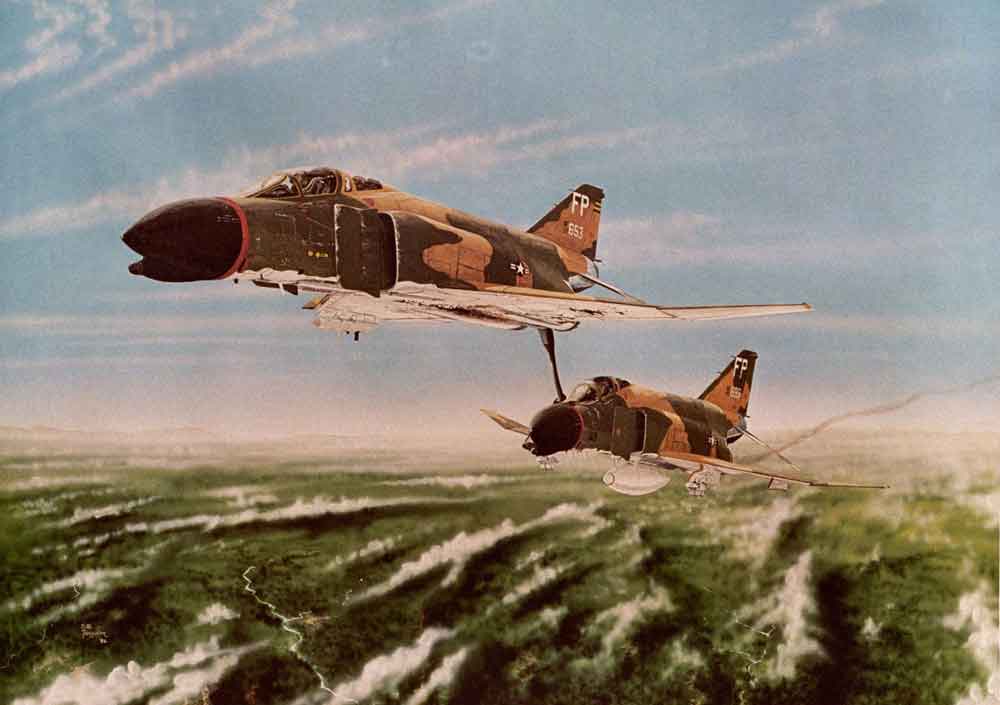 It was March 10th, 1967. North Vietnam’s only steel mill, thirty miles north of Hanoi, had been enjoying the cover of low clouds during the beginning of monsoon season. Strike packages had been trying to annihilate this target for more than a week but couldn’t get close due to the weather. Even if they could get close, this was the most heavily-defended target in the history of aerial warfare. But this day the skies were clear and the strike package was given a “Go.” They departed their base at Ubon Royal Thai Air Force Base [Click here to read more…]
It was March 10th, 1967. North Vietnam’s only steel mill, thirty miles north of Hanoi, had been enjoying the cover of low clouds during the beginning of monsoon season. Strike packages had been trying to annihilate this target for more than a week but couldn’t get close due to the weather. Even if they could get close, this was the most heavily-defended target in the history of aerial warfare. But this day the skies were clear and the strike package was given a “Go.” They departed their base at Ubon Royal Thai Air Force Base [Click here to read more…]
When I undressed, the cause of the leg discomfort became visible. Because I had on a flight suit and a G-suit which protected the area, something struck with enough force to barely break the skin, and create a bruise the size of a softball. We surmised the 23mm cannon took off the canopy, and a large piece of that struck my leg. For the next couple of weeks my friends cut up my food for me and I learned to do everything left-handed.
Blue Three, my leader that day, never flew another combat mission. He had five children back home and convinced the Brass that he could best serve the Air Force as a maintenance officer back in Japan.
About a week after the incident, and before the flight surgeon released me for flight, my commanding officer called me aside and made me an offer: “How would you like to serve the rest of your tour at 5th Air Force Head Quarters back in Tokyo?”
Talk about a soft job! I told him, “Sir, I appreciate your concerns and generous offer, but the only thing that got hurt the other day was my ego. I want to go back up North just as soon as the doctor puts me back on Flight.” The CO, who was a personal friend from the Hamilton Field days, said, “I knew you were going to say that, but I wanted to make the offer. You’ll be back on the schedule as soon as the Doc gives the OK.”
Time in the F-86’s was premium. You normally could only use them for combat. When the Doc put me back on flight status, they called me into Operations and told me to take the F-86 Sabre out in front and see how things feel. I took the aircraft up, alone, for about an hour and everything felt great. I often think that was one of the best gestures I’ve ever seen. Everything felt so good I went back up North 66 more times for a total of 72 missions. After my return North, I was successful in recording three probable kills during dog fights.
- A Kill: when the enemy pilot ejects from the aircraft or it is seen striking the ground.
- A Probable Kill: in all probability, the enemy aircraft did not return safely to base. This is decided because (and confirmed by gun camera film) the enemy aircraft belching black smoke, sporting visible flames, and/or flying erratically.
- Damage: evidence of your fire striking them, but not causing serious damage.
Of my three probables, two made it back across the Yalu River (which we couldn’t cross), and with the third, my wingman came under attack and we were forced to break off before I could finish the kill.
Stay tuned for Korea Files 3: Charles “Charlie” Ray Spath
Featured Image: courtesy of USAF






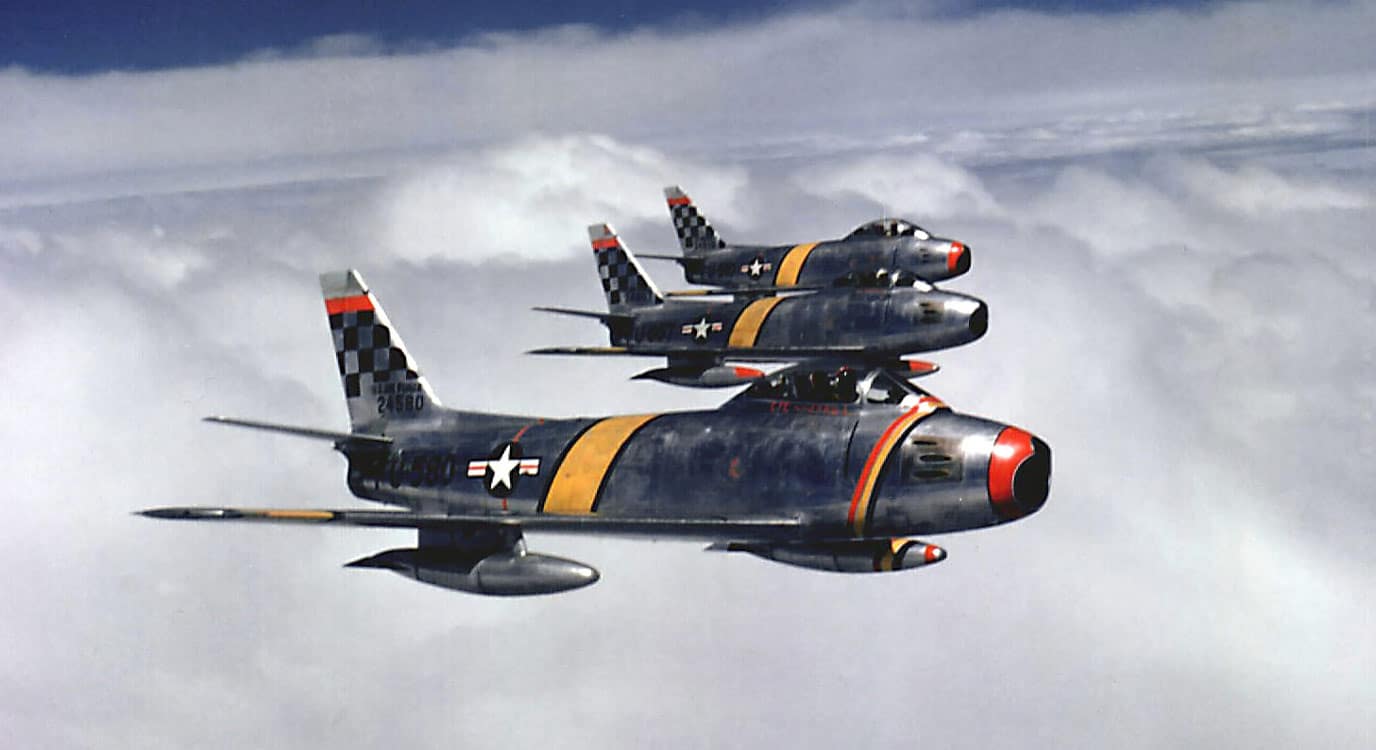






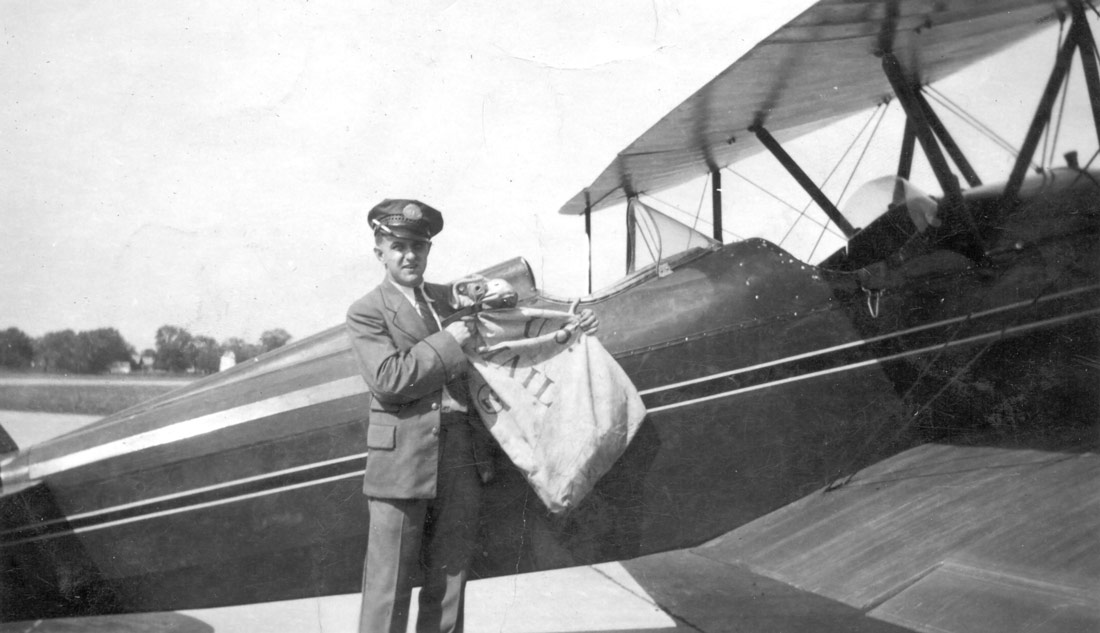
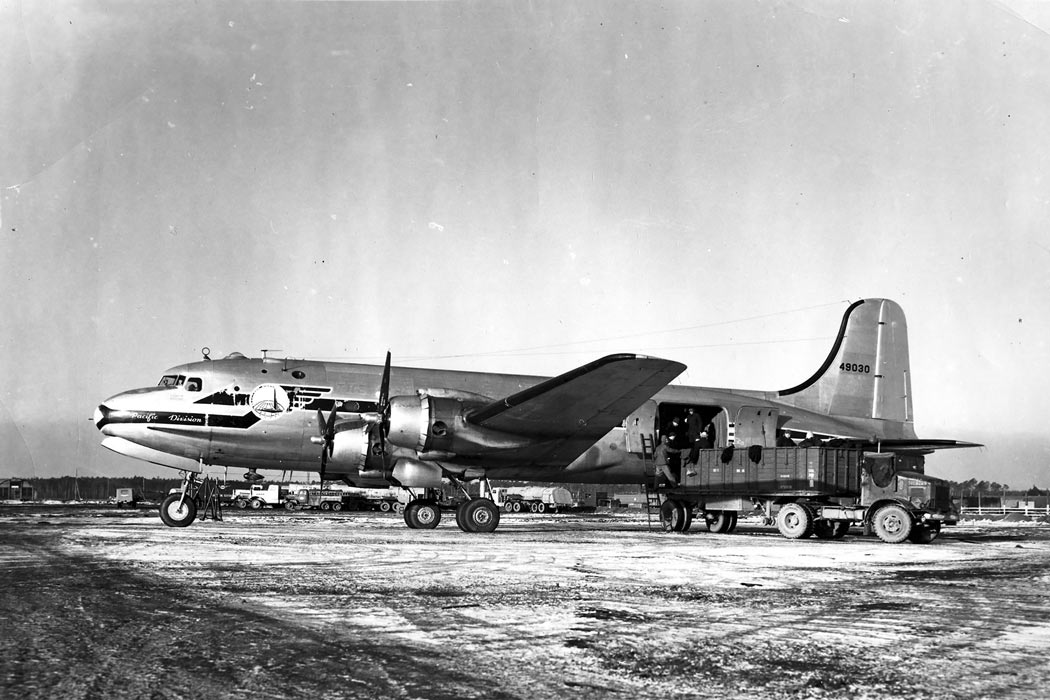
Great story, would love to hear more. Did you get around to Korea Files 3: Charles “Charlie” Ray Spath? Would love to hear about how you guys navigated with radio beacons since you didn’t have GPS..
James, Bill provided us with six installments of the Korea Files, which you can find here:
//disciplesofflight.com/author/b-todd/
Thanks!
Hi Anders. I am with the American Fighter Aces Association. Is Bill still alive today ? Do you have any information on the man that responded to Bill in his story about George Davis.
Regards,
Gregg Wagner
AFAA
Board Member, Honoree, Historian